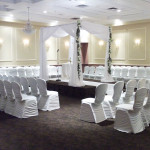 Jewish weddings vary depending on the region and the country in which the ceremony is being held, but in all instances, they follow the Jewish laws and traditions. There are four common elements in most Jewish weddings. There is a marriage contract, called a ketubah, which is signed by the couple and two witnesses. A marriage ceremony is held under a wedding canopy, called a chuppah, and while under the canopy, a ring owned by the groom is given to his bride. Then the most famous of all elements, the breaking of the glass.
Jewish weddings vary depending on the region and the country in which the ceremony is being held, but in all instances, they follow the Jewish laws and traditions. There are four common elements in most Jewish weddings. There is a marriage contract, called a ketubah, which is signed by the couple and two witnesses. A marriage ceremony is held under a wedding canopy, called a chuppah, and while under the canopy, a ring owned by the groom is given to his bride. Then the most famous of all elements, the breaking of the glass.
Today, the whole process starts when a man asks a woman to marry him and gives her a ring or an object of value. In the old days a matchmaker was used to find a potential match for a man. Today, the man and woman can do this for themselves. However, in recent years, with the high divorce rates, there has been a return to the matchmaker tradition for making a good match. After a match is agreed upon, the wedding planning begins.
Before the wedding ceremony can begin, the marriage contract must be signed by the couple and witnessed by two other people. This legally binding contract spells out the details and obligations of this union. Frequently this contract is written in a calligraphy styled manuscript page that is framed for display in the home. Traditionally, this is read at the wedding, or a shorter version thereof.
The bride’s face is covered with a veil because in the Old Testament Jacob was tricked into marrying Leah instead of Rachel. The groom is usually ushered into the ceremony by the two fathers and the bride is escorted by the two mothers. When the bride arrives at the canopy, she walks around the groom seven times, symbolizing the seven blessings. During the presentation of the rings, two prayers are recited and wine is tasted by the couple. The groom then places the ring on the right hand of his bride in the presence of two witnesses (required by Jewish law). If the bride is giving the groom a ring also, it is presented at this time. This is followed by a reciting of the seven blessings. After each blessing, the groom and his bride are given a sip of wine. At the end of the ceremony, the groom smashes a glass with his right foot and the guests shout, “Mazel tov!”
The couple then retreats to a private room for 10-15 minutes; this is called yichud, meaning togetherness or seclusion. According to tradition, seclusion is needed to complete the ceremony. The couple then meets their guests for the equivalent of a wedding reception. There is dancing and singing and some more rituals. The bride’s mother is crowned with flowers and her daughters dance around her. The parents have a special dance together when their last child is wed. The gladdening of the bride is one of the dances; everyone dances around the bride with banners, confetti, costumes, signs, and table napkin jump ropes.
The Mitzvah tantz is when special guests, family members, or rabbis dance for the couple. This dance was made famous in the movie, “Fiddler on the Roof” when the Russians did the traditional bottle dance. A line of black suited men in deep plié, arms linked, bottles on their heads, thrust their legs out to each side and inch forward with each movement. Mozel tov!
The Avenue Banquet Hall can offer kosher catering. They also have a separate ceremony room and complimentary chupa. The Avenue is the ideal wedding venue in Vaughan


Leave a Reply